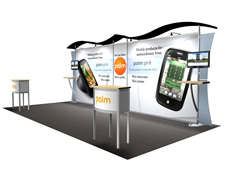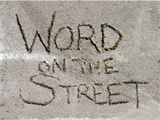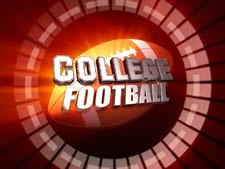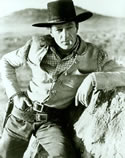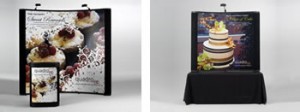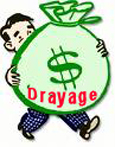Several weeks ago, we added Frequently Add Questions to Exhibit Design Search. There are over 90 questions/answers in this FAQ database. Now, we aren’t foolish enough to think you’ll read them all in one sitting, although we’d be very flattered if you did. Instead, we’ll share samples in the Trade Show Tales blog over the next week or so. We know you read the blog. We have statistics to prove it!!
We’ll begin with the very popular Sacagawea Portable Hybrid Display System:
1. What is a portable hybrid display?
Generally, portable hybrid displays incorporate aluminum extrusion, tension fabric, and other display components to create a modern-looking tabletop or inline display. For a more comprehensive explanation, refer to the article: 10 Things to Consider Before Buying a Portable Hybrid Display.
Our portable hybrids assemble primarily with attached knobs, and the designs are unlike any other hybrids in the world: upscale, contemporary, and very affordable.
2. What makes Sacagawea different from your other hybrid systems, such as Visionary Designs, Perfect 10, and Magellan?
Sacagawea blends upscale design with aggressive pricing that’s perfect for anyone looking for a lightweight hybrid display. Choose from three attractive design series, 65 compact and versatile displays, and terrific 10 ft. and 20 ft. configurations with multiple options.
With Visionary Designs, anything is possible – portable, modular, custom, and custom-hybrid designs. Visionary Designs can be any size, any shape, any configuration. Think of the display kits as idea generators rather than final designs.
Anyone who loves curves, loves Magellan because the kits are all about curved metal and large tension fabric graphics. The most popular have been the Miracle and MOR, which (not surprisingly) are also the most affordable.
Perfect 10 assembles without tools and comes in a mind-boggling assortment of color and shape options, all included in the standard price.There’s no other display like Perfect 10, because not other system has the patented Perfect 10 S-Shape.
3. What are the key features of Sacagawea?
Sizes: Table Tops, 10 x 10, 10 x 20, Pedestals, and Workstations.
Kits: 65 standard kits.
Straight Aluminum Extrusions: Mostly straight extrusions with MODUL S40 uprights and Z45 horizontals.
Graphics: Primarily one large tension fabric graphic @ 7.5 ft x 6.75 ft with a smaller tension fabric graphic and/or direct print graphics. Velcro tension fabric connections.
Assembly: MOSTLY attached knobs with some hex key connections. Individual numbered parts with detailed setup instructions.
Colors: (9) Sintra/Plex Wing colors. (1) Standard extrusion color: Silver (clear satin anodized).
Packaging: LT-550 Portable roto-molded case(s) with die-cut foam inserts.
Bottom Line: Least expensive, mostly straight extrusions, primarily knob assembly, medium-large graphics. Ideal for anyone considering a pop up display.
4. Why did you choose the name Sacagawea?
As you may recall, Sacagawea was a Lemi Shoshone woman who accompanied Lewis and Clark on their expedition between 1804 and 1806. She was the only woman.
Sacagawea served as a guide and an interpreter for the expedition, but her greatest value to the mission may have been simply her presence during the arduous journey, which showed their peaceful intent.
The Sacagawea Hybrid System, named in honor or this remarkable woman, is a lightweight, adaptable display system which packs in one or two portable cases. It’s durable, attractive, and makes a big impression at any show or event.
For more information about Sacagawea or the Lewis and Clark Expedition, click on the links.
5. What is a tension fabric graphic?
Tension fabric graphics attach to a frame so the fabric is taut edge-to-edge, creating “tension.” Typically, the graphic has Velcro hook sewn along the border, usually top and bottom, and attaches to Velcro loop on the frame. A silicone bead or welting can also be sewn to the edge of the tension fabric graphic. Those are referred to as Silicone Edge Graphics(SEG).
What are the benefits of fabric graphics vs. traditional first surface graphics?
- Flexibility. An array of fabric options and finishing exists. Fabric graphics can be adapted to just about any hardware
- Storage and Shipping. Fabric is lighter than many other graphics. Fold your graphics neatly when in storage and take up much less space.
- Care. Fabric graphics can be washed and steamed and are just as durable and long lasting as traditional graphics.
- Lightweight. Larger graphics weigh less, perfect for draping or creating space definition.
- Cost. More image bang for the buck!
- Green. There are the obvious transportation and storage benefits. Even more exciting is the growing list of fabric options created from recycled materials.
- No Glare. Fabric is the perfect choice for media walls or any backdrop that is being photographed or filmed.
- Versatility. Fabric can be applied to most display and hardware options and is perfect for skinning or covering displays or objects. Custom covers can be created to drape over objects, wrap, or completely pillowcase them!
Next, Quadro S Pop Up Displays.




